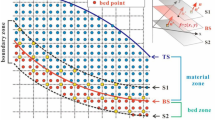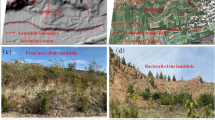Abstract
The simulation of near-surface typhoon wind fields is crucial for high-precision typhoon hazard assessments and thus of great significance for disaster forecasting, loss risk assessment and emergency management. The terrain correction method for simulating regional large-scale wind fields has a single correction method that cannot satisfy the requirements of refined risk assessment. This paper aims to use the advantage with regard to accuracy of the fluid dynamics mechanism model (CFD, computational fluid dynamics) in small-scale wind speed simulations and obtain a terrain correction method suitable for simulating regional large-scale wind fields by extracting the spatial variation of the wind speed over complex terrain. Specifically, typical mountains with different cross-sectional shapes and slopes are used to characterize the undulating terrain, and the CFD model is used to simulate and analyze the wind speed changes on the upwind and leeward slopes, at the mountain top, and in the downwind area under different initial wind speeds. The wind speed at these locations has a good quantitative relationship with the initial wind speed. Combined with the typical building wind load codes in China, the wind speed correction algorithm suitable for large-scale complex terrain is supplemented and improved. This paper presents the simulation results of three typhoons, and taking Typhoon No. 0713 as an example, a near-surface typhoon wind field simulation is performed. Compared with that of other models, the accuracy of the terrain-corrected simulation results by the method provided in this article is increased by 8.8–16.89%. Such CFD-based typhoon disaster near-surface wind fields can more accurately reflect the spatial distribution and intensity of typhoon wind hazards over large-scale complex terrain and can provide technical support for the loss risk prediction and assessment of forest resources, mountain forestry economies, crops and other vulnerable bodies during typhoon disasters.





Similar content being viewed by others
References
Alexander D (2000) Confronting catastrophe: new perspectives on natural disasters. Oxford University Press, Oxford
ASTGTM https://lpdaac.usgs.gov/products/astgtmv003/. https://doi.org/10.5067/ASTER/ASTGTM.003
Building structure load code [S]. GB50009-2012. 2012 (in Chinese)
Cheng CK, Yuen KK, Lam KM, Lo SM (2005) CFD wind tunnel test: field velocity patterns of wind on a building with a refuge floor. Int J Comput Fluid Dyn 19(7):531
Cheng H, He J, Xu X, Zou X, Wu Y, Liu C, Dong Y, Pan M, Wang Y, Zhang H (2015) Blown sand motion within the sand-control system in the southern section of the Taklimakan Desert Highway. J Arid Land 7(5):599–611
Dong L, Li JZ, Xu YJ, Yang YT, Li XM, Zhang H (2021) Study on the spatial classification of construction land types in Chinese cities: a case study in Zhejiang Province. Land 10(5):523
Grasshopper, https://www.grasshopper3d.com/page/tutorials-1
Griffiths A, Middleton J (2010) Simulation on separated flow over two-dimensional hills. J Wind Eng Ind Aerodyn 98(3):155–160
Holland GJ (1980) An analytic model of the wind and pressure profiles in hurricanes. Mon Weather Rev 108(8):1212–1218
Holland GJ (2008) A revised hurricane pressure: wind model. Mon Weather Rev 136(9):3432–3445
Ishihara T, Hibi K, Oikawa S (1999) A wind tunnel study of turbulent flow over a three-dimensional steep hill. J Wind Eng Ind Aerodyn 83:95–107
Jinping O, Zhongdong D, Liang C (2002) Analysis of typhoon hazard in key cities along the Southeast coast of China. J Nat Disasters 04:9–17 (in Chinese)
Li Z, Wei Q, Sun Y (2010) Influence of mountain topography on wind vibration response of transmission tower. Power Grid Technol 34(11):214–220. https://doi.org/10.13335/j.1000-3673.pst.2010.11.001 (In Chinese)
Li ZL, Xu SY, Xiao ZZ et al (2016) Detailed interpolation distribution of wind speed and terrain correction coefficients along mountain slopes. J Hunan Univ 43(03):23–31. https://doi.org/10.16339/j.cnki.hdxbzkb.2016.03.00 (In Chinese)
Lin W, Fang W (2013) Research on the regional characteristics of Holland B coefficient in the northwest pacific typhoon wind field model. Trop Geography 33(02):124–132 (In Chinese)
Lou WJ, Liu MM, Li ZH et al (2016) Research on mean wind speed characteristics and speed-up effect in canyon terrain. J Hunan Univ 43(7):8–15 (In Chinese)
Lu XQ, Yu H, Ying M, Zhao BK, Zhang S, Lin LM, Bai LN, Wan RJ (2021) Western North Pacific tropical cyclone database created by the China meteorological administration. Adv Atmos Sci 38(4):690–699. https://doi.org/10.1007/s00376-020-0211-7
Maharani YN, Lee S, Lee YK. (2009) Topographic effects on wind speed over various terrains: a case study for Korean Peninsula. In: The Seventh Asia-Pacific conference on wind engineering. Taipei
Ngo TT, Letchford CW (2009) Experimental study of topographic effects on gust wind speed. J Wind Eng Ind Aerodyn 97(9–10):426–438
Qian Li, Zhongdong D (2005) Shapiro typhoon wind field model and its numerical simulation. J Nat Disasters 01:45–52 (in Chinese)
Shen GH, Yao D, Lou WJ et al (2016) Investigation of the wind field characteristics on Isolated hill and two adjacent hills using CFD numerical simulation. J Hunan Univ 43(1):37–44 (In Chinese)
Shun K, Huirong W (2009) Discussion on the feasibility of applying CFD to the prediction of wind speed distribution in wind farms. J Eng Thermophys 29(12):2400–2042
Uchida T (2018) Computational fluid dynamics approach to predict the actual wind speed over complex terrain. Energies 11(7):1694
Vickery PJ, Dhiraj W (2008) Statistical models of Holland pressure profile parameter and radius to maximum winds of hurricanes from flight-level pressure and H*Wind data. J Appl Meteorol Climatol 47(10):2497–2517
Weihua F, Wei L (2013) Summary of research on typhoon wind field models for disaster risk assessment. Geographical Sci Progress 32(06):852–867 (in Chinese)
Ying M, Zhang W, Yu H, Lu X, Feng J, Fan Y, Zhu Y, Chen D (2014) An overview of the China Meteorological Administration tropical cyclone database. J Atmos Oceanic Technol 31:287–301. https://doi.org/10.1175/JTECH-D-12-00119.1
Funding
This research was funded by the National Key Research and Development Program of China, Grant Numbers 2017YFA0604903 and 2017YFA0604904, which are funded by the Ministry of Science and Technology of the People’s Republic of China.
Author information
Authors and Affiliations
Corresponding author
Ethics declarations
Conflict of interest
We declare that we have no financial and personal relationships with other people or organizations that can inappropriately influence our work, there is no professional or other personal interest of any nature or kind in any product, service and/or company that could be construed as influencing the position presented in, or the review of, the manuscript entitled.
Consent for publication
This paper is original and has not been published elsewhere. The process and results are true presentations and have not been tamper with or forge. The research involved in this paper is not a complete process, and the research has not been divided to publish a larger number of papers. The relevant literature cited is needed for support, and there are no improper self-citations.
Additional information
Publisher's Note
Springer Nature remains neutral with regard to jurisdictional claims in published maps and institutional affiliations.
Supplementary Information
Below is the link to the electronic supplementary material.
Rights and permissions
About this article
Cite this article
Yang, Y., Dong, L., Li, J. et al. A refined model of a typhoon near-surface wind field based on CFD. Nat Hazards 114, 389–404 (2022). https://doi.org/10.1007/s11069-022-05394-9
Received:
Accepted:
Published:
Issue Date:
DOI: https://doi.org/10.1007/s11069-022-05394-9




